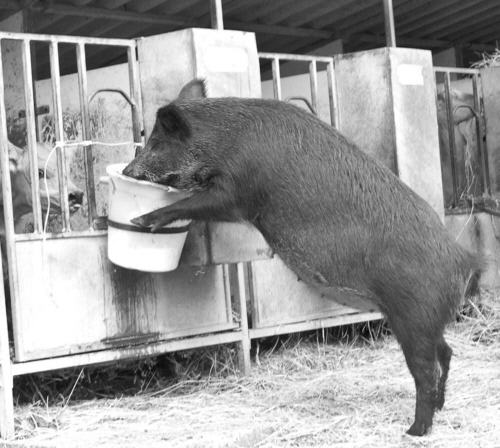This farm is situated between the east coast of Sardinia in the region Baronia and the highway 131. The farm dates from the 50s when the father of Pino Murgia, after having worked hard in the mines of Belgium, decided to go home. marry and have children. On his return, he bought two cows, while the other peasants had bought oxen. Even though cows aren’t as strong as oxen, they can have calves and produce milk. Not having any property of his own, the commune let his cows graze on a communal field. Gradually he bought land, extending it when possible and now his sons Piro and Mirco are managing the farm.
Having passed some fields, we arrived at the farm of the Murgia family. Just having arrived and gone out of the car, we heard someone say “good morning” even though we couldn’t see the person who had greeted us. Then, Pino who had been milking a goat, appeared.
In fact, the goats resided in small adjacent cells divided by wooden walls and each door were constructed with rods, but with an opening through which it was possible to feed them.
Near the cells for the goats, there was a barn where there were about 10 Bruno-Alpina cows which were attached to a sort of fence such that they could reach hay on the other side of the fence. Having milked the goats, he liberated four of the cows which immediately walked to the adjacent building in order to be milked. Obviously, they knew where to go since they walked to their assigned places without any guidance. Having cleaned the udder and attached a cup to each teat, the milking was done by a machine. Having finished the milking, the cows were allowed to enter a field, while Pino filled a container with milk from one of the cows. He brought the container to another cell with a calf inside and positioned the container such that the calf could get milk from its mother via a teat. During our whole stay, a wild boar was moving around freely, and while the calf was sucking milk from the bucket, the wild boar tried to tip it and also to rise above the bucket such that it could reach the milk. Fortunately, the calf managed to drink the milk all by itself.
A group of young oxen lives separately in a shed.
Since Pino got a phone call and had to go, we went to the hotel of the Murgia family a short distance from the farm. It’s called Anna-Caderina village-hotel and it’s the name of the mother of Loretta, the sister of Pino and Mirco and the manager of the hotel. It has been built on land which wasn’t arable.
On our way back to Poasada, we passed a flock of sheep and about 3 guarding dogs. In fact, this farm has about 300 sheep.
The milk of the animals was brought to Posada where we were watching the mother of Pino, Anna Caderina, prepare cheese. Having poured the milk into a container, she heated it to about 40 degrees, she added rennet (an enzymic compound extracted from the stomachs of calves) in order to separate the fat parts from the liquid. She stirred the milk with a stick occasionally and after about 15-20 minutes, the milk was becoming dense and turning into curd. Then, she got hold of the fat pars, that is the cheese mass, with her hands and brought it to the surface, lifted it and put it in a small container with lots of holes in the bottom such that the remaining liquid, called the whey, could escape by means of gravity. In the beginning, she also compressed and turned the cheese mass around in order to speed the expelling of the whey.
Having extracted all the cheese mass, she reheated the remaining whey in order to make ricotta. She stirred the whey occasionally and after some time, it was possible to see that it was turning dense and irregular layers were forming on the surface with liquid remaining between them. At this time, she used a utensil to pick up the ricotta and transfer it to another set of holed containers. This time, she allowed the remaining whey to escape solely by means of gravitation. The remaining liquid would be given to the pigs and the free-ranging wild boar such that everything would be used. The cheese mass would be turned into pear-shaped cheeses after our departure.
This farm sells meat, sausages and pear-shaped cheese directly to customers.

